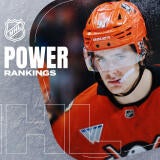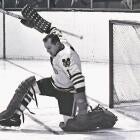Grit, toughness, and building a better fourth line
At some point hockey people -- both those within the game and those that make their living talking and writing about it -- decided that a fourth-liner in the NHL absolutely has to be a certain type of player. And that player doesn't really do much.

More NHL: Scores | Standings | Odds | Fight-O-Meter | League Leaders | Rumors
At some point hockey people -- both those within the game and those who make their living talking and writing about it -- decided that a fourth-liner in the NHL almost always has to be a certain type of player.
This player is usually described with several buzzwords and phrases.
He has to have grit. He has to be tough. He has to be physical. He has to be difficult to play against (a phrase that can have multiple meanings). If he can also happen to fight and go up against the NHL's "heavyweights" and drop the gloves, then you've gone and created the best type of fourth-line player, as that guy simply has all of the key ingredients.
Other than actually being able to play hockey in a meaningful way.
There is absolutely nothing wrong with a player having any or all of those traits (though the fighting can not only be pointless, it can also at times be a liability) as physical play definitely serves a purpose and has a place in the game. But he has to be able to do other things that lend themselves to actually winning games. When you start acquiring players who are "tough" just for the sake of acquiring a player who is "tough," and has no other tangible skill or asset as a player (or worst of all, a player who is capable of only fighting), that's when you start running into problems and putting your team at a sizable disadvantage.
Even if you're only asking him to play seven or eight minutes a night as a fourth-liner.
On Monday morning the Edmonton Oilers traded a fourth-round draft pick to the Toronto Maple Leafs in exchange for veteran forward Mike Brown. This is an example of a team looking for the wrong qualities on its fourth line.
When we last talked about Brown, we were looking at his role in Toronto as one of the players that contributed to their league-leading fight total (he's been involved in five this season) and how meaningless many of them were and probably will continue to be. While he is the definition of "tough," he's not a particularly good NHL player. Despite that, the Oilers gave up more for him than the New Jersey Devils gave up for Andrei Loktionov a few weeks ago, a young player with a decent amount of talent and upside, and was skating with New Jersey's top forwards on Monday night (the Devils only gave up a fifth-round pick for him).
The timing of the deal was especially interesting as it came less than 24 hours after the Oilers lost to the Minnesota Wild on Sunday night, a game in which they were outshot 18-0 in the second period. Think about that for a second and try to wrap your head around it, if you can.
An NHL team, a group of highly paid, highly trained professionals, played a full 20-minute portion of a game and not only did not generate a single shot, but also gave up 18 to one of the worst offensive clubs in the league. This is not a team that needed to run out and acquire a tough guy for the sake of acquiring a tough guy. Especially when the team already has tough guys like Ben Eager, Lennart Petrell and Darcy Hordichuck on its payroll as options to fill out its bottom lines.
(And let's keep in mind that it was a team that a year ago traded a talented, puck-moving defenseman in Tom Gilbert for Nick Schultz, and acquired Marc Fistric this offseason in the name of adding, you guessed it, more toughness to its defense. One of the worst in the NHL.)
Edmonton didn't (and doesn't) need tougher players; it needed (and still needs) better players. A position that it's still in after giving up a mid-round pick for Brown.
Let's hop in our time machine and go back a full calender year to last March and a comment from Los Angeles Kings coach Darryl Sutter -- a coach who led his team to a Stanley Cup title last June, and currently has that same team starting to hit its stride this year.
(Emphasis in the quote below is mine.)
"It’s a diminished role," Sutter told Rich Hammond of Kings Insider last March when talking about fighters and their place in the NHL. "It’s like I told those young kids [Jordan Nolan and Kyle Clifford], they’re not fighting anybody. There’s like five or six of those guys left in the league, (to play) two or three minutes a night. We’d rather those guys be on the ice, because then we can take advantage of it. If it’s just about staged fighting, I’m not into that. I don’t think Jordan or Cliffy, those kids should ever be in that situation.’’
When Sutter took over the Kings, the previous head coach, Terry Murray, was regularly dressing fighter Kevin Westgarth in his lineup. That stopped almost instantly when Sutter took over and the Kings fourth line was then made up of guys like Brad Richardson, Jordan Nolan, Colin Fraser and Kyle Clifford. Those guys all have toughness, but they also have enough skill to consistently outplay other teams' fourth-line tough guys and fighters. And that was a huge advantage for the Kings last season.
In other words: if your opponent is going to dress John Scott or Colton Orr, that opponent is either going to shorten its bench and have a guy that's only going to play two or three shifts a night (like Scott) or can simply be outplayed for eight or nine minutes a night (like Orr). By dressing a fighter of your own to counter that guy, you're simply validating the other coach's decision to essentially waste one of his roster spots and not use a player who can actually outplay somebody.
There is absolutely nothing wrong with having a player on your fourth line that has some talent. And he does't need to be a grizzled, rugged veteran who is going to skate around and "bang some bodies" and "drop the gloves."
The ultimate goal in hockey is to outplay the guy who's lined up across from you.
Control the puck. Create shots. Score more goals than him. That's what wins hockey games, whether it's coming from a top line or a fourth line.
Just look at some of the fourth lines of recent Stanley Cup winners and finalists. There's the aforementioned Kings line of Nolan, Richardson and Fraser. The 2009 Penguins had Miroslav Satan (a former 40-goal scorer and probably the antithesis of a tough, physical, fourth liner) and Pascal Dupuis skating between Craig Adams, a player they picked up on waivers at the trade deadline. The 2011 Bruins had fighter Shawn Thornton on their fourth line, but surrounded him with Gregory Campbell and Daniel Paille, two players with enough talent to at least help outplay other fourth liners and keep the play moving. The Detroit Red Wings teams in 2008 and 2009 that went to the finals regularly used youngsters like Darren Helm and Justin Abdelkader on their fourth line.
When we talk about players who are "tough to play against" we always think of it is as physical play (and I've been guilty of it, too). But what type of player is harder to play against? A relatively skilled player who can control the puck and make you defend him; or a player who can't keep the puck and will bang you around after you've already made a pass or taken a shot?
I'd go with the latter.
Yet you still see teams loading up on toughness and fighters just because that's what your fourth line is supposed to be. Because that's what teams "need" on that line. Just this past week we saw the Calgary Flames give up an asset in a trade for Brian McGratten.
When the Buffalo Sabres watched Ryan Miller get run over by Milan Lucic last season, the response of the players made the front office decide they needed to be tougher. So they traded top-line center Derek Roy for Steve Ott, and then went out and signed John Scott to round out their fourth line. Scott is one of those five or six guys that Sutter talked about. He's dressed in 18 games for the Sabres this season and averaged three minutes of ice time per night, recording zero points and four shots on goal. When he's in the lineup the Sabres are basically playing with a 17-man roster that night.
The Toronto Maple Leafs' much-talked about fourth line, which is now made up of Orr, Frazer McLaren, and Dave Steckel, played just four minutes on Monday night and in those four minutes was amazingly victimized for two goals -- the only two goals Toronto surrendered in a 4-2 win.
Hey, you won't beat them up in the parking lot after the game (or on the ice during it), but what you will do is beat them on the scoreboard.
For more hockey news, rumors and analysis, follow @EyeOnHockey and @Agretz on Twitter and like us on Facebook. Also, subscribe to our YouTube Channel.

















